
Monthly Archives: July 2011
Gourmet Underground Detroit's content archives are organized by date and catalog the aggregated content of our Features pages as well as our blog.
Anthology Coffee
As though we all weren’t caffeinated enough already, we metro Detroiters are clearly in the midst of a regional coffee explosion. Never have there been so many roasters, so many cafes, so many interesting coffees from which to choose. Perhaps I’m overstating it since coffee is a fairly new thing to me – but I’m pretty sure that my Coffee Explosion Theory is on the money.
Consider: The hype-worthy Corktown spot Astro Coffee opened last week (they’ll get their own GUD post or series of praiseworthy poems soon enough). Great Lakes continues to replace hazelnut flavored sludge with real coffee across the area and to sell new microlots or new blends at Eastern Market. And of course, you couldn’t go 15 minutes without hearing about them on WDET for the better part of the last year. Lab Cafe, Comet Coffee, and the storefront for Mighty Good all opened in Ann Arbor within the past 18 months or so. Commonwealth Coffee arrived in Birmingham only several months back.
And now it turns out that the in-house roastmaster at Commonwealth is also selling coffee under his own label.
Anthology showed up at Comet Coffee in Ann Arbor a few weeks ago. I needed a bag of beans to grind and brew on my office Chemex setup, and the half pound allotment from this ostensibly tiny roastery of which I’d never heard was the freshest on the shelf. Despite the somewhat hefty price tag, my inability to resist a compelling east African coffee took hold of my arm, and before I knew it, I was back in the office making up a batch of his Karimikui AA coffee from Kirinyaga, Kenya. (AA, I learned only a week or so ago, is a grade designation for coffee beans that means larger than normal beans. While it’s apparently not universal that larger beans mean more flavor, there is some degree of association there.)
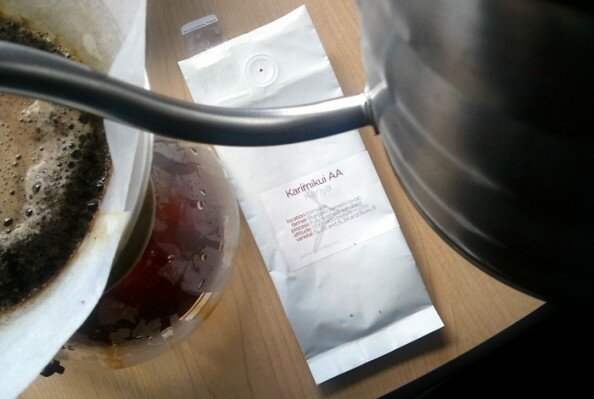
It’s pretty delicious stuff. There’s bitterness, but it’s more akin to a hoppy saison or a grapefruit in that it’s acidic and fruity while bitter (rather than more “simply” bitter). While I only ever drink my drip coffee unadulterated, the flavor is plenty full, fruity, and sweet, so I can’t imagine that anyone would add much in the way of sugar or cream to this. The next day, when I made some more, it tasted more like cocoa, but the finish remained mildly bitter and cleansing.
As with goods sold by just about any tiny new operation, cost is going to be a barrier for all but the nerdiest, most dedicated customers. The 8-ounce (250g) package I bought was $16. When compared to some of the better single origin offerings from larger outfits from Great Lakes to Intelligentsia to Counter Culture, that’s an awfully steep price.
Still, the coffee was good, and that’s ultimately what matters most. And it’s made here, part of this ongoing influx – no, I mean EXPLOSION – of delicious, interesting coffees. They’re also currently selling another Kenyan, a peaberry from the same farm/co-op, which I haven’t tried yet.
If you want to buy some, I’d check out Comet in Ann Arbor or just head to the Anthology website, where it appears their first two coffees are available for purchase.
Italian Women Winemakers
First posted at drinkart
God knows I love Italian women and Italian wine. At the Louis Dressner trade tasting in Chicago on March 23, I had the opportunity to chat up a few Italian winemakers. Just to say their names aloud makes it seem as if you are singing: Sonia Torretta, Nadia Verrua, Alessadra Venturini, Elisabetta Foradori, and Arianna Occhipinti. It also sounds like a poem or an Italian dinner menu or an angry parliamentary debate in Romae. What I loved about these women were their faces, each one unique and expressive. The wines were equally so.
 Nadia Verrua of Cascina Tavijn doesn’t take any crap.
Nadia Verrua of Cascina Tavijn doesn’t take any crap.
The first table we met Nadia Verrua of Cascina Tavijn and Sonia Torretta of Cascina degli Ulivi. I was a big fan of the Ulivi Gavi Filagnotti from Western Market and a dinner Putnam Weekley had done at El Barzon in Detroit, truly a funky cold medina of a white wine. Sonia had brought the Gavi and Semplicimente Bianco which are made from white Cortese grapes farmed biodynamically. They are aged in botti or large acacia wood barrels until Spring. The Gavi is a great apertif wine with fruity tones while the Semplicimente favors the minerally and has no sulfur dioxide added. There were two reds as well, another Semplicimente Rosso and a Monferrato Dolcetto Nibio. The Rosso is a blend of Barbera and Dolcetto grapes with no sulphur added. It ages on the skins in French oak barrels. Quite a nice early sipping red and great with food for those who are so inclined to pair the two. The Dolcetto is from a plot of red clay and limestone and ferments on the skins for 40 days. This is a very traditionally made wine with great aromas and tanins for long lasting lushness. Nibio is local dialect for the dolcetto grape which has been hanging in the hills of Piemonte and Liguria for at least 1000 years.
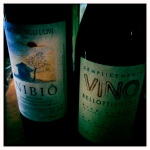 No sulfur dioxide, now that’s pretty semplicemente.
No sulfur dioxide, now that’s pretty semplicemente.
Sonia had on some sweet yellow Asics shoes and she and Jarred hit it off because he had worn his Asics of many colors. I, for a change, was wearing grown-up leather shoes (at least they had pointy toes). She was making me thirsty and hungry talking about her biodynamic farm with its bed and breakfast, fruit trees and local produce. She is truly dedicated to biodiversity. She grows ancient varieties of grains, including spelt, and raises heritage chickens and cattle for cheese and beef. She and I bonded over my tales of trips to Piemonte in the days when we imported Lavazza coffee. We discussed my coffee roasting and trips to Lavazza’s massive coffee roasting facility on the outskirts of Torino. I know Detroit Mayor Bing went to Torino to see how the city survived after the economic tides turned on Fiat and its manufacturing base there. Here’s a thought: more Piemonte wines and free appetizers at the local bars. And by appetizers, I don’t mean chicken wings. Soon enough, Sonia had produced a demi-tasse of Lavazza espresso.
 Lavazza in Sonia’s tazza.
Lavazza in Sonia’s tazza.
There was no time for espresso now, even as espresso as it is. We had Italian wines to drink and more invitations to b & b’s in the Italian hinterlands to collect. Nadia Verrua had brought two wines from Cascina Tavijn: a Grignolino d’Asti and a Ruche de Castagnole Montferrato. Much like the name Tavijn, these grapes were of a distinct local dialect.
 Bottles to marry a native for.
Bottles to marry a native for.
The Grignolino d’Asti is a really light red. It has a pale rose color and could almost be a rosé except that there was more going on, a lot more. This is a wine you want to drink immediately with a plate of cured coppa while wearing really loud colored sneakers. I made coppa for the first time this year and I’ve got the sneakers covered. Let’s party. But is that also some earth and pepper? Some orange blossom? What the devil did she do to make this wine? It was putting a hex on me. This is also a full-on chill and chill wine. The Ruché may be slightly more well-known grape than these offbeat native varieties, but not by much. It is pronounced Rue-K and sounds like a Japanese baseball pitcher. If you put Ruché in the game, chalk up a save. Ruby red bordering on a Prince-like purple, Tavijn Ruché is no shrinking violet. Well, it does have some very flowery aromas but with 30 days on its skins, it has some serious structure. Who wouldn’t want skin in this game?
americano is the sheeit – still life with rene mosse
Nadia also sells some grignolino grapes to Mauro Vergagno who uses them in his incredible non vintage Vino Aromatizzato Americano chinato. In this case, unlike the coffee game, Americano doesn’t refer to something stupid like adding water to espresso, but to the bitter (amer) aspect of the drink. Just to give a small measure of respect to the fellas, we did spy Marc Olivier shlurping down a special cocktail Mauro Vergano made: chinato with sparkling water, ice and orange peel. This may be the best and most simple cocktail I’ve ever tasted. Yeah, dog!
After the super animated duo of Sonia and Nadia, Alessandra Venturini of Monte dall’Ora was positively demure. Not that there’s anything wrong with that. Sometimes Italians are so Comedia dell’Arte that we are shocked at an Italian who is subdued and serious or just shy. Monte dall’Ora had three Valpolicellas and an Amarone. I had to refocus a bit on the wines and not the personalities I had been so enjoying. Rustic is what hit me at first, then authentic. I have not tasted too many Valpolicellas so I was at first without a frame of reference. I tasted, took some notes then came back again. Alessandra explained that the vineyards, organically farmed, face the city of Verona in the Veneto. Jarred and I were if not normally, very gentlemanly as we imbibed. The Valpolicella Classico Saseti was very cherry with notes of wet grass. It is a blend of local natives: 40% Corvina, 30% Corvinone, 20% Rondinella and 10% Molinara and Oseleta. At 12% alcohol, I could drink this wine all day and all of the night. The Ripasso is made in the tradional manner of a secondary fermentation of the Classico on the skins in the March following harvest. Like coaxing the inherent sweetness from coffee by concentrating polyphenols, this wine is concentrated and could be considered the little brother of Amarone. My tasting notes for the Amarone said semplicemente, “f’ing amazing.”

From Verona north to the Dolomites, I met one of the stars of the Italian women winemakers constellation: Elizabetta Foradori. Just to repeat the name Foradori is an exercise in the romance languages. This woman is positively charming, elegant. Elizabetta was conversing with another taster so I began by tasting through her portfolio while waiting for an audience. You could see her passion both in the way she was using her hands while talking as well as in the bottle. Instead of in a dream or on a website, there was a magnum of Teraldego Sgarzon just waiting for me on the table. Dream or reality, I reached for the bottle and poured out some wine for myself. Tonnerre de Dieu. I don’t even know how you say in Italian, thunder, madness, wonderment. Who is John Galt? All the talent of Atlas Shrugged squirreled away in some mountain retreat in the Dolomites instead of Colorado, this wine was revolutionary. Sgarzon is a gravelly parcel in the cool climes of the mountains. The grapes are vinified on the skins, open fermentation in clay anfora for eight months. Fleshy, fruity, acidy, soft tannins, Elizabetta how do you do?
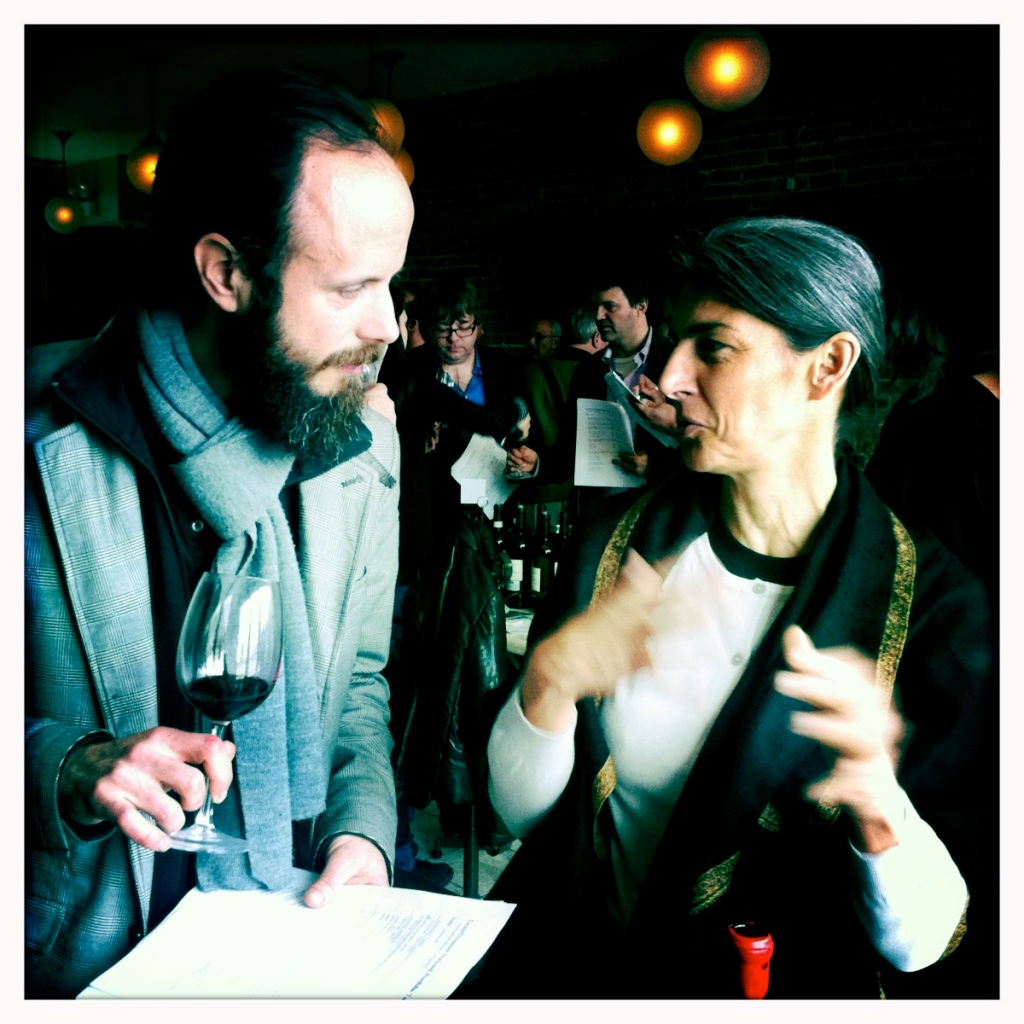
When you talk to Elizabetta, no one else is in the room. The thing I like about the Louis Dressner tastings is to see the different faces of the winemakers. These people live their work. You can see it and taste it. Relationships sell wine, nothing else. You cannot improve on that. Everything else is a commodity based on price. She explained that the poverty of soil helps grapes develop a certain character. Why date the static prettiest girl when you could date a lively girl with character and longevity. Remember this is a post about Italian women winemakers. The Fontanasanta Nosiola proves this thesis. It is from a small two hectare plot, fermented in open anfora followed by 2 months ageing in acacia and oak: traditional but dynamic. Before we had finished talking, I was planning to take her up on an offer to visit the Dolomites.

The finale was of course Arianna Occhipinti. Her wines, and those of her uncle at COS, from Sicily have been coveted among our crew for some time. SP68 while it sounds like a sunscreen rating, could have been the highway between Chambers Street Wines in NYC and several Gourmet Undergrounders here in the Detroit area. Instead it is a highway in Sicily which runs past the vineyards where Occhipinti performs her transformative winemaking from vineyards hugging the slopes of Mt. Etna.
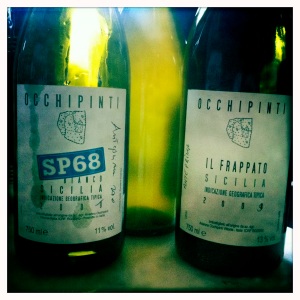 party juice
party juice
Il Frappato sounds like you might experience a karate chop to the sternum. You might after I’ve had a glass or two. This wine has an acidity that is positively baller. It has notes of raspberry and a distinct earthiness. The wine is fresh and pure. Arianna was also featuring a line of wines, Frappato included, made for a wine bar called Tami which are now available in the Detroit area at a lower cost. Tami has become a clarion call for natural wines. She farms biodynamically and whether you get it or think it’s bunk, the wines are so expressive they will hug you into submission.
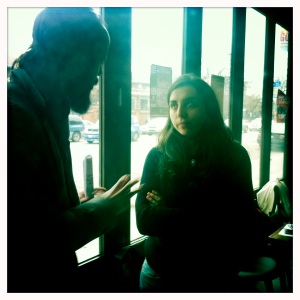 no way you’re getting a hug dude
no way you’re getting a hug dude

The great thing about wine tastings is the afterparty. It’s hard work to talk and pour wine all day. I can only imagine the repetitive and inane questions that flow from our gobs as we gulp down wine after wine. I gained a couple insights in this regard. For the Italians, many of whom are from out of the way locales, the big cities like Chicago, NY and San Fran are full of things they haven’t seen before. Often they haven’t even tasted each others’ wines. It was my distinct pleasure to introduce Nadia Verrua to Marc Olivier’s sans soufre (no sulfur added) Bulles Petillant. At 9.5% with no added sugar, this wine is a party starter. We gathered in the main room after consolidating all the open bottles and chug-a-lugged the petillant naturel or pet’nat sparkling melon de bourgogne. It is a fresh, fruity quencher, a veritable vin de soif, more sincerely embracing than a two handed handshake.

The other revelation was that after drinking so much wine, the logical progression was Mexican beer. All the winemakers crowded into a booth and ordered Tecates for all their friends. Friends, faces, now that’s refreshing.
All pictures taken by @jarred_, stealth photographer and gentleman of leisure.
The Bitter Kitty
Several of my colleagues are in love with Hello Kitty.
In the 2 seconds it took to digest that sentence, you’ve surely thus realized that also means they’re in love with the color pink. So infatuated with both every shade of pink and every incarnation of Hello Kitty are they that the two are practically inseparable in my mind.
Thus when I came up with a drink so very vibrant and self-assured in its own pink-ness, I had to come up with some kind of title that properly honored these friends of mine.
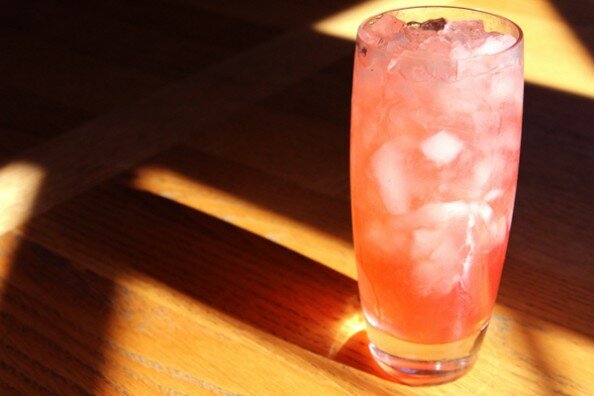
The Bitter Kitty: A Campari Swizzle of Sorts
- 1.5 oz white rum (I used Mt. Gay)
- .75 oz lemon juice
- .5 oz falernum (I made my own, but look for Velvet Falernum)
- .5 oz Campari
- .25 oz lemoncello (I used Luxardo)
- Prepare as you would a swizzle, which is to say the ingredients should be added to a glass with crushed ice and stirred until the glass has acquired a frosty chill.
- Alternatively, if you’re not in the mood to crush ice, you can simply shake the ingredients and pour over a few large ice cubes.
I prepared this drink for the GU Detroit picnic this year, and over the past few weeks, I’ve had a few people ask for the recipe. So I figured it’d be worth posting here. (In fact, I’d actually already posted this recipe, but since that time, I’ve altered it a bit and greatly prefer the newest version.)
Mess with the preparation notes at your own risk. I use my own homemade falernum in this drink, which is heavily rum based, so that’s basically more than 2.5 ounces of hooch. Without that dilution from swizzling or shaking, this gets aggressively boozy. Of course, when properly diluted and chilled, it’s poundably quaffable, and you’ll be drunk as hell in no time. Not that such a state of being is a problem.
Enjoy!
Keeping it Simple?
Living in a country so full of choice and diversity means it’s not necessarily surprising that we can be in the midst of two distinct culinary movements. While molecular gastronomy is producing meals straight off the set of Star Trek, farm-to-table advocates and naturalists are preparing old fashioned meals using only a knife, a stove, and a handful of top-shelf ingredients.
Considering the ever-expanding Alinea empire and the success of Gabrielle Hamilton’s new book and the ongoing success of her restaurant, it seems there’s more than enough room for both of these approaches.
The same is true of cocktails. The New York Times just published an article a couple of weeks ago highlighting the contrast between the push for more infusions, more ingredients, more complexity and truly simple, refreshing summer cocktails. They published a list of recipes, and at first glance, each of the drinks looks delicious.
What puzzles me are the people who are so desperately opposed to one approach or the other.
Back in 2007, Alain Ducasse said he preferred “to be able to identify what I’m eating” and that a preponderance of molecular technique would mean “we would be in trouble.” A blog post over at Epicurious last year basically slammed molecular gastronomy though the author admitted she hadn’t been exposed to many good examples. And it’s not hard to find people railing against avocado and ligonberry infused spirits. Or something along those lines.
Conversely, I’ve seen interviews where some of these guys look at conventional approaches with a future-versus-past attitude that borders on disdain.
What gives?
I’m a firm believer that every tool has a purpose and that anything that tastes good has a place in this world. Simple, complicated, old school, high tech, rustic, innovative — who cares? Different chefs or bartenders will have different approaches and different visions, but none of them are inherently invalid.
To me, there’s not really much to say on the subject other than there’s always reason to appreciate any technique, any ingredient that helps make us smile at the dinner table, at the bar, or at a restaurant. Who could really argue with that?
Fol Epi – Swiss Cheese from France
If you hang with the Gourmet Underground you probably already know about our weakness for wines from the Loire Valley of France. From Muscadet to Touraine, there are few bottles from the region that we haven’t drained with enthusiasm. But there is more than wine being imported from Loire.
 Fol Epi is a cow’s milk cheese produced from the renowned dairy of Pays de Loire and inspired by the great Swiss Emmental cheeses. In French, Fol Epi means wild wheat stalk and the unique loaf shape and embossed decoration echo its name. The wheat-based rind is dusted with toasted wheat flour and said to contribute to the flavor but it’s the pale meat inside the rind that turns us on the most.
Fol Epi is a cow’s milk cheese produced from the renowned dairy of Pays de Loire and inspired by the great Swiss Emmental cheeses. In French, Fol Epi means wild wheat stalk and the unique loaf shape and embossed decoration echo its name. The wheat-based rind is dusted with toasted wheat flour and said to contribute to the flavor but it’s the pale meat inside the rind that turns us on the most.
Aged for three months, Fol Epi has a firm but not hard texture with a just a slight elasticity that’s pleasant to the bite. Small, sporadic eyes, or holes, are comparable to some Swiss cheeses but not quite as large or frequent as the typical deli case Swiss. The flavor is subtle, nutty, and somewhat sweet with just a hint of fruitiness. It’s a delicate cheese yet not so fragile to be overwhelmed by mild cured meats or ripe fruit.
At around $13 a pound it is not cheap but we’ve found that it’s a versatile cheese that can appeal to both snobs and the casual snacker. Some might even call it a gateway cheese. Snag a hunk at R. Hirt in Detroit’s Eastern Market.
